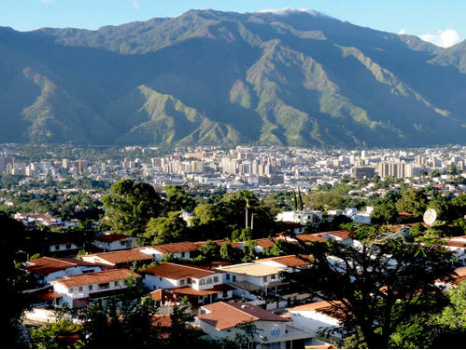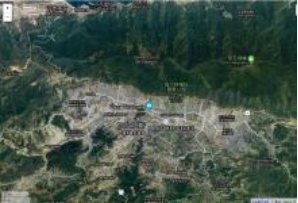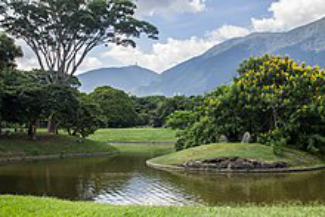Caracas, Venezuela 作者: 来源: 发布时间:2021-03-23
1. Population and Area
Caracas , officially Santiago de León de Caracas, abbreviated as CCS, is the capital and largest city of Venezuela, and the center of the Metropolitan Region of Caracas (or Greater Caracas). Caracas is located along the Guaire Riverin the northern part of the country, within the Caracas Valley of the Venezuelan coastal mountain range (Cordillera de la Costa).
State: capital district
Area: 433 km2 (167 sq mi)
Population(2017): 2,245,744

2. Geography
Caracas is contained entirely within a valley of the Venezuelan Central Range, and is separated from the Caribbean coast by a roughly 15-kilometre (9 mi) expanse of El Ávila National Park. The valley is relatively small and quite irregular, and the altitude varies from between 870 and 1,043 meters (2,854 and 3,422 ft) above sea level; the historic center lies at about 900 meters (3,000 feet) above sea level. This, along with the rapid population growth, has profoundly influenced the urban development of the city. The most elevated point of the Capital District, wherein the city is located, is the Pico El Ávila, which rises to 2,159 meters (7,083 feet).

The main body of water in Caracas is the Guaire River, which flows across the city and empties into the Tuy River, which is also fed by the El Valle and San Pedro rivers, in addition to numerous streams which descend from El Ávila. The La Mariposa and Camatagua reservoirs provide water to the city. The city is occasionally subject to earthquakes – notably in 1641 and 1967.
Geologically, Caracas was formed in the Late Cretaceous period, with much of the rest of the Caribbean, and sits on what is mostly metamorphic rock. Deformation of the land in this period formed the region.
Transportation:
The Caracas Metro has been in operation since 27 March 1983. With 4 lines, 47 stations and about 10 more to be constructed. It covers a great part of the city and also has an integrated ticket system that combines the route of the Metro with those offered by the Metrobús, a bus service of the Caracas Metro. In 2010, the first segment of a new ariel cable car system opened, Metrocable which feeds into the larger metro system.
Buses are the main means of mass transportation. There are two bus systems: the traditional system and the Metrobús. Other transportation services include the IFE train to and from the Tuy Valley cities of Charallave and Cúa; the Simón Bolívar International Airport, the biggest and most important in the country; the metro additional services Caracas Aerial Tramway and Los Teques Metro (connecting Caracas with the suburban city of Los Teques); and the Generalissimo Francisco de Miranda Air Base used by military aviation and government airplanes.
3. Economy
Businesses that are located in Caracas include service companies, banks, and malls, among others. It has a largely service-based economy, apart from some industrial activity in its metropolitan area.
Several international companies and embassies are located in El Rosal and Las Mercedes, in the Caracas area. The city also serves as a hub for communication and transportation infrastructure between the metropolitan area and the rest of the country. Important industries in Caracas include chemicals, textiles, leather, food, iron, and wood products. There are also rubber and cement factories. Its nominal GDP is US$70 billion and the GDP (PPP) per capita is US$24,000.
A 2009 United Nations survey reported that the cost of living in Caracas was 89% of that of the survey's baseline city, New York.However, this statistic is based upon a fixed currency-exchange-rate of 2003 and might not be completely realistic, due to the elevated inflation rates of the last several years.
Tourism
In 2013, the World Economic Forum evaluated countries in terms of how successful they were in advertising campaigns to attract foreign visitors. Out of the 140 countries evaluated, Venezuela came last. A major factor that has contributed to the lack of foreign visitors has been poor transport for tourists. Venezuela has limited railway systems and airlines. High crime rates and the negative attitude of the Venezuelan population towards tourism also contributed to the poor evaluation.
In an attempt to attract more foreign visitors, the Venezuelan Ministry of Tourism invested in multiple hotel infrastructures. The largest hotel investment has been in the Hotel Alba Caracas. The cost for the general maintenance of the north and south towers of the hotel is approximately 231.5 million Venezuelan bolivars. Although the Venezuelan Ministry of Tourism has taken the initiative to recognize the importance of the tourism industry, the Venezuelan government has not placed the tourism industry as an economic priority. In 2013, the budget for the Ministry of Tourism was only 173.8 million bolivars, while the Ministry of the Youth received approximately 724.6 million bolivars.The tourism industry in Venezuela contributes approximately 3.8 percent of the country GDP. The World Economic Forum predicts Venezuela's GDP to rise to 4.2 percent by 2022.
4. Industry
The Caracas Stock Exchange and Petróleos de Venezuela (PDVSA) are headquartered here. PDVSA, a state-run organization, is the largest company in Venezuela, and negotiates all the international agreements for the distribution and export of petroleum. When it existed, the airline Viasa had its headquarters in the Torre Viasa.
The Caracas Stock Exchange
The Caracas Stock Exchange or Bolsa de Valores de Caracas (BVC) is a stock exchange located in Caracas, Venezuela. Established in 1947, BVC merged with a competitor in 1974. BVC is a private exchange, providing operations for the purchase and authorized sale of securities according to the Capital Marketing Laws of Venezuela. It is member of the Executive Committee of the Latin American Federation of Stock markets. At the exchange, companies emit by procedures authorized by the regulating authorities, instruments of fixed income and securities (renta fija y de renta variable) with the purpose of securing capitalfrom public investors. BVC is also used as a location for trading in Bonds and other debtinstruments.
Petróleos de Venezuela
Petróleos de Venezuela, S.A. (PDVSA, Spanish pronunciation: [peðeˈβesa]) (English: Petroleum of Venezuela) is the Venezuelan state-owned oil and natural gas company. It has activities in exploration, production, refining and exporting oil as well as exploration and production of natural gas. Since its founding on 1 January 1976 with the nationalization of the Venezuelan oil industry, PDVSA has dominated the oil industry of Venezuela, the world's fifth largest oil exporter.
Oil reserves in Venezuela are the largest in the world and the state-owned PDVSA provides the government of Venezuela with substantial funding resources. Following the Bolivarian Revolution, PDVSA was mainly used as a political tool of the government. Profits were also used to assist the presidency, with funds directed towards allies of the Venezuelan government.
With PDVSA focusing on political projects instead of oil production, mechanical and technical statuses deteriorated while employee expertise was removed following thousands of politically-motivated firings. Incompetence within the company has led to serious inefficiencies and accidents as well as endemic corruption. As a result, thousands of workers have abandoned their work for PDVSA, especially after PDVSA was put under military control.
5. Landmarks
Paseo Los Próceres
The Paseo Los Próceres is a monument located near Fort Tiuna and the Military Academy of the Bolivarian Army. On the promenade there are statues of the heroes of the Independence of Venezuela, as well as symbolic sculptures.
Federal Capitol
The Federal Capitol occupies an entire city block, and, with its golden domes and neoclassical pediments, can seem even bigger. The building was commissioned by Antonio Guzmán Blanco and was built between 1872–1877, and is most famous for its Salón Elíptico, an oval hall with a mural-covered dome and walls lined with portraits of the country's great and good. The nearby Palacio Municipal de Caracas dating from 1696 was renovated in the Neoclassical style in 1906 and now serves as the city hall and the Caracas Museum.
East Park

A view of the Parque del Este
The Caracas East Park (Parque del Este, now officially Parque Generalísimo Francisco de Miranda) was designed by Brazilian architect Roberto Burle Marx. It is a green paradise in the middle of the city, and it contains a small zoo. A replica of the ship led by Francisco de Miranda, the Leander, is in the southern part of the park. Before there used to exist a replica of the Santa Maria ship, used by Christopher Columbus in his voyages to America.
Teresa Carreño Cultural Complex
The Teresa Carreño Cultural Complex (Complejo Cultural Teresa Carreño) is by far the most important theater of Caracas and Venezuela. The theater presents symphonic and popular concerts, operas, ballet, and dramatic works. It is the second largest theater in South America, after the Teatro Colón of Buenos Aires, Argentina.
Colonial painting of Our Lady of Caracas, Patroness of the city, and below the city (circa 1766).
Simón Bolívar's Birthplace Home
Skyscrapers may loom overhead, but there is more than a hint of original colonial flavor in this neatly proportioned reconstruction of the house where Simón Bolívar was born on 24 July 1783. The museum's exhibits include period weapons, banners and uniforms.
Much of the original colonial interior has been replaced by monumental paintings of battle scenes, but more personal relics can be seen in the nearby Bolivarian museum. The pride of the place goes to the coffin in which Bolívar's remains were brought from Colombia; his ashes now rest in the National Pantheon.National Pantheon
Venezuela's most venerated building is five blocks north of Plaza Bolívar, on the northern edge of the old town. Formerly a church, the building was given its new purpose as the final resting place for eminent Venezuelans by Antonio Guzmán Blanco in 1874.
Parque Central Complex
At a short distance east of Plaza Bolívar is Parque Central, a concrete complex of five high-rise residential slabs of somewhat apocalyptic-appearing architecture, crowned by two 56-storey octagonal towers, one of them is under repair due to the fire which burnt the building on 17 October 2004.
Parque Central is Caracas' art and culture hub, with museums, cinemas and the Teresa Carreño Cultural Complex. The West Tower balcony, on the 52nd floor, gives a 360° bird's-eye view of Caracas.
6.Culture and history
Culture
Caracas is Venezuela's cultural capital, with many restaurants, theaters, museums, and shoppingcenters. The city is home to many immigrants from Spain, Italy, Portugal, the Middle East, Germany, China, and other Latin American countries.
History
Before the city was founded in 1567, the valley of Caracas was populated by indigenous peoples. Francisco Fajardo, the son of a Spanish captain and a Guaiqueri cacica, who came from Margarita, began establishing settlements in the area of La Guaira and the Caracas valley between 1555 and 1560. Fajardo attempted to establish a plantation in the valley in 1562 after these unsuccessful coastal towns, but it did not last long: it was destroyed by natives of the region led by Terepaima and Guaicaipuro. Fajardo's 1560 settlement was known as Hato de San Francisco, and another attempt in 1561 by Juan Rodríguez de Suárez was called Villa de San Francisco, and was also destroyed by the same native people. The eventual. settlers of Caracas came from Coro, the German capital of their Klein-Venedig colony around the present-day coastal Colombia–Venezuela border; from the 1540s, the colony had been de facto controlled by Spaniards. Moving eastward from Coro, groups of Spanish settlers founded inland towns including Barquisimeto and Valencia before reaching the Caracas valley.
On 25 July 1567, Captain Diego de Losada laid the foundations of the city of Santiago de León de Caracas. De Losada had been commissioned to capture the valley, and was successful by splitting the natives into different groups to work with, then fighting and defeating each of them. The town was the closest to the coast of these new settlements, and the colonists retained a native workforce, which allowed a trade network to develop between Caracas, the interior, and Margarita; the towns further inland produced ample cotton products and beeswax, and Margarita was a rich source of pearls. The Caracas valley had a good environment for both agricultural and arable farming, which contributed to the system of commerce but meant that the town's population was initially sparse, as it was only large enough to support a few farms.
In 1577, Caracas became the capital of the Spanish Empire's Venezuela Province under the province's new governor, Juan de Pimentel (1576–1583). In the 1580s, Caraqueños started selling food to the Spanish soldiers in Cartagena, who often docked in the coastal city when collecting products from the empire in South America. Wheat was growing increasingly expensive in the Iberian Peninsula, and the Spanish profited from buying it from Caracas farmers. This cemented the city in the empire's trade circuit.
During the 16th and 17th centuries, the coast of Venezuela was frequently raided by pirates. With the coastal mountains of the Central Range as a barrier, Caracas was relatively immune to such attacks, compared to other Caribbean coastal settlements, but in 1595 the Preston–Somers expedition landed and around 200 English privateers, including George Somers and Amyas Preston, crossed the mountains through a little-used pass while the town's defenders were guarding the more frequently used one. Encountering little resistance, the invaders sacked and set fire to the town after a failed ransom negotiation. The city managed to rebuild, using wheat profits and "a lot of sacrifice". In the 1620s, farmers in Caracas discovered that cacao beans could be sold, first selling them to native people of Mexico and quickly growing across the Caribbean. The city became important in the Viceroyalty of New Spain, as well as moving from largely native slave labor to African slaves, the first of the Spanish colonies to become part of the slave trade. The city was successful and operated on cacao and slave trade until the 1650s, when an alhorra blight, the Mexican Inquisition of many of their Portuguese traders, and increased cacao production in Guayaquil greatly affected the market. This and the destructive 1641 earthquake put the city into decline, and they likely began illegally trading with the Dutch Empire, which Caraqueños later proved sympathetic to; by the 1670s, Caracas had a trading route through Curaçao.
In 1728, the Guipuzcoan Company of Caracas was founded by the king, and the cacao business grew in importance. Caracas was made one of the three provinces of Nueva Granada, corresponding to Venezuela, in 1739. Over the next three decades the Viceroyalty was variously split, with Caracas province becoming the Venezuela province and then the Captaincy General of Venezuela in 1777, with Caracas as the capital. Venezuela then attempted to become independent, first with the 1797 Gual and España conspiracy, based in Caracas, and then the successful 1811 Venezuelan Declaration of Independence. Caracas then came under worse luck: in 1812, an earthquake destroyed Caracas, a quarter of its population migrated in 1814, and the Venezuelan War of Independence continued until 24 June 1821, when Simón Bolívar defeated royalists in the Battle of Carabobo. Urban reforms only took place towards the end of the 19th century, under Antonio Guzmán Blanco: some landmarks were built, but the city remained distinctly colonial until the 1930s.
7. Other information
The Central University of Venezuela (Universidad Central de Venezuela, UCV) is a public university founded in 1721: it is the oldest university in Venezuela. The university campus was designed by architect Carlos Raúl Villanueva and declared a UNESCO World Heritage Site in 2000.
Caracas has one of the highest per capita murder rates in the world, with 111.19 homicides per 100,000 inhabitants.
8. Contact Information
Address: Caracas 1014, Capital District
Website: http://www.caracas.gob.ve/
Facebook: Alcaldía de Caracas
Twitter: @Alcaldiade_Ccs
Chief of government: Darío Vivas
